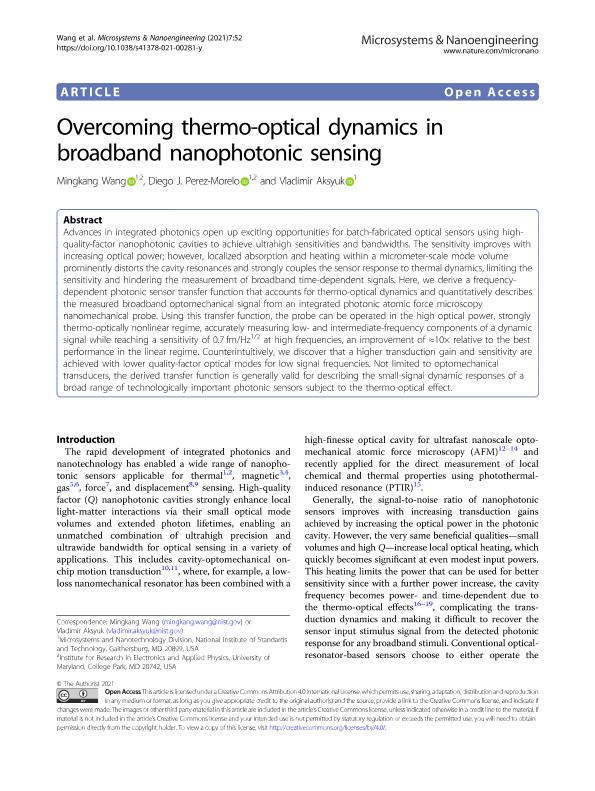Mostrar el registro sencillo del ítem
dc.contributor.author
Wang, Mingkang
dc.contributor.author
Perez, Diego Javier

dc.contributor.author
Aksyuk, Vladimir
dc.date.available
2022-12-19T11:56:50Z
dc.date.issued
2021-12
dc.identifier.citation
Wang, Mingkang; Perez, Diego Javier; Aksyuk, Vladimir; Overcoming thermo-optical dynamics in broadband nanophotonic sensing; Nature Publishing Group; Microsystems and Nanoengineering; 7; 1; 12-2021; 1-11
dc.identifier.uri
http://hdl.handle.net/11336/181700
dc.description.abstract
Advances in integrated photonics open up exciting opportunities for batch-fabricated optical sensors using high-quality-factor nanophotonic cavities to achieve ultrahigh sensitivities and bandwidths. The sensitivity improves with increasing optical power; however, localized absorption and heating within a micrometer-scale mode volume prominently distorts the cavity resonances and strongly couples the sensor response to thermal dynamics, limiting the sensitivity and hindering the measurement of broadband time-dependent signals. Here, we derive a frequency-dependent photonic sensor transfer function that accounts for thermo-optical dynamics and quantitatively describes the measured broadband optomechanical signal from an integrated photonic atomic force microscopy nanomechanical probe. Using this transfer function, the probe can be operated in the high optical power, strongly thermo-optically nonlinear regime, accurately measuring low- and intermediate-frequency components of a dynamic signal while reaching a sensitivity of 0.7 fm/Hz1/2 at high frequencies, an improvement of ≈10× relative to the best performance in the linear regime. Counterintuitively, we discover that a higher transduction gain and sensitivity are achieved with lower quality-factor optical modes for low signal frequencies. Not limited to optomechanical transducers, the derived transfer function is generally valid for describing the small-signal dynamic responses of a broad range of technologically important photonic sensors subject to the thermo-optical effect.
dc.format
application/pdf
dc.language.iso
eng
dc.publisher
Nature Publishing Group

dc.rights
info:eu-repo/semantics/openAccess
dc.rights.uri
https://creativecommons.org/licenses/by/2.5/ar/
dc.subject
Photonics sensor
dc.subject
MEMS
dc.subject
Transfer function
dc.subject
Thermo-optical effect
dc.subject.classification
Óptica

dc.subject.classification
Ciencias Físicas

dc.subject.classification
CIENCIAS NATURALES Y EXACTAS

dc.title
Overcoming thermo-optical dynamics in broadband nanophotonic sensing
dc.type
info:eu-repo/semantics/article
dc.type
info:ar-repo/semantics/artículo
dc.type
info:eu-repo/semantics/publishedVersion
dc.date.updated
2022-10-04T14:43:36Z
dc.identifier.eissn
2055-7434
dc.journal.volume
7
dc.journal.number
1
dc.journal.pagination
1-11
dc.journal.pais
Reino Unido

dc.journal.ciudad
Londres
dc.description.fil
Fil: Wang, Mingkang. National Institute Of Standards And Technology; Estados Unidos. University of Maryland; Estados Unidos
dc.description.fil
Fil: Perez, Diego Javier. Consejo Nacional de Investigaciones Científicas y Técnicas. Oficina de Coordinación Administrativa Ciudad Universitaria. Unidad Ejecutora Instituto de Nanociencia y Nanotecnología. Unidad Ejecutora Instituto de Nanociencia y Nanotecnología - Nodo Bariloche | Comisión Nacional de Energía Atómica. Unidad Ejecutora Instituto de Nanociencia y Nanotecnología. Unidad Ejecutora Instituto de Nanociencia y Nanotecnología - Nodo Bariloche; Argentina. National Institute Of Standards And Technology; Estados Unidos. University of Maryland; Estados Unidos
dc.description.fil
Fil: Aksyuk, Vladimir. National Institute Of Standards And Technology; Estados Unidos
dc.journal.title
Microsystems and Nanoengineering
dc.relation.alternativeid
info:eu-repo/semantics/altIdentifier/url/http://www.nature.com/articles/s41378-021-00281-y
dc.relation.alternativeid
info:eu-repo/semantics/altIdentifier/doi/http://dx.doi.org/10.1038/s41378-021-00281-y
Archivos asociados
